
Chapter
1. Coarse Woody Debris in Forests and Plantations of CoastalThomas A. Spies and Steven P. Cline
Summary
The forest portion of the ecosystem is the sum of three diverse, mutually dependent components: physical structures, biological entities, and ecological functions. These components are dynamic, continually developing diversity.

Figure 1.1-Mosaic of stands created by wildfire, showing patches of snags and trees that survived the fire.
Introduction
Diversity develops in a forest as a result of changes that occur at different rates at different places. Disturbances cause relatively rapid changes in ecosystems, whereas succession slowly returns ecosystems to previous conditions or directs them to new states. Structural diversity in the current mosaic of forest age classes was created by a variety of disturbances, such as fire and wind, and this mosaic changes from succession and new disturbances (fig. 1.1, color). Today’s forested coastal landscape bears the legacy of many landscapes in the form of remnant old-growth trees, snags, fallen trees, landslides, and patches of young and mature forests.
The forest’s character changes with succession. Net primary productivity is greater in young forests than in old ones. Old forests conserve nutrients, whereas very young forests are susceptible to erosion and nutrient loss (Franklin and others 1981). Forests of the Coast Range interior valleys produce less wood than do those on more moist sites nearer the ocean. And internally, the old unmanaged forest is more diverse than many young and mid-age forests. Old forests have deeper, multilayered canopies, larger accumulations of coarse woody debris (any dead standing or fallen tree stem at least 4 inches in diameter at breast height (d.b.h.) on snags and at the large end on fallen trees), and more specialized plants and animals than young forests have. A coastal Oregon forest may change slowly through growth, succession, mortality, and decay, or it may be altered rapidly by catastrophic disturbance. Whatever the agent of change, the imprints of previous forests and disturbances persist into succeeding forest generations. Organic material in the form of dead tree stems is one of the more persistent legacies. This material exerts ecological influences on a site for hundreds and thousands of years; first, as snags and fallen trees; later, as fine organic matter in the soil. These organic remains create seed germination sites, moisture reservoirs during summer drought, sites of nutrient exchange for plant growth, habitat for forest organisms, and favorable soil structure.
Page 5
The Unmanaged Forest
The major agents of disturbance are fires, winds, insects, diseases, and accelerated mass soil and debris movements. Disturbance, along with forest stand development and plant succession, helps create the coarse woody debris that is part of the forest.
Forest Disturbances
Wildfire of various intensities and sizes has been the most significant catastrophic disturbance throughout the Coast Range (Martin and others 1976). Some fires have burned more than a million acres, and many areas have reburned within 30 years.
Two of the many large wildfires in the Coast Range are especially impressive. In1849, a fire between the Siletz and Siuslaw Rivers burned more than one-half-million acres (Morris 1936). Many fires have burned in a patchy manner, creating a very complex mosaic of dead and live trees. Humans have strongly influenced the dynamics of woody debris in the Coast Range through accidental or intentional setting of fires. Between 1933 and 1951, for example, the many Tillamook burns covered 335,000 acres, killing more than 13 billion board feet of timber (Lucia 1983). Large, severe fires add massive amounts of coarse woody debris to the ecosystem because large branches, stems, and most of the coarse woody debris are not consumed by the fire (Harmon and others 1986) (fig. 1.2).

Figure 1.2-Amounts of coarse woody debris after a fire that killed an old growth stand.
Page 6

Figure 1.3-Blowdown patch in a spruce-hemlock stand.
Windthrow, the next most important catastrophic forest disturbance, is common in the Coast Range where hurricane-force gales are recorded several times each year (Badura and others 1974). Such events in 1950, 1953, 1957, and 1958 caused extensive damage (Childs and Clark 1953, Lynott and Cramer 1966, Ruth and Yoder 1953). During the "Columbus Day" storm of October 12, 1962, 11 billion board feet of timber was blown down in western Oregon and western Washington (Orr 1963). Tree mortality from wind damage adds dead wood directly to the forest floor, in contrast to fire damage that usually leaves dead trees standing for many years (fig. 1.3).
Wind-caused mortality also creates a different successional pathway than does fire mortality. Wind increases the proportion of shade-tolerant species, such as western hemlock, because understory trees are released after the canopy dominants are removed. Thus, when trees in the released stand die, the contribution of dead wood is from smaller diameter, more rapidly decomposed western hemlock stems. Western hemlock stands lacking massive successional dominants, such as Douglas-fir or Sitka spruce, accumulate less coarse woody debris than do stands with these dominants.
Page 7
Although insects have occasionally caused catastrophic mortality in Coast Range forests, they usually inflict only scattered mortality. Outbreaks of the Douglas-fir bark beetle often follow other events that kill and damage trees (Furniss and Carolin1977). Such an outbreak, a patchwork of small groups of trees in recently killed timber, spreads to nearby trees where the insects form galleries in the phloem and girdle the trees. The beetles also introduce a fungus that plugs the conductive tissues in the vascular system. Trees killed by bark beetles usually die standing, although decay has already begun.
Laminated root rot fungus is a primary pathogen of Douglas-fir and western redcedar in the Coast Range. This fungus is not a direct agent of catastrophic mortality because patches of mortality are relatively small (about 0.25 acre) and spread slowly (about 1 ft/yr) (Gedney 1981, Nelson and others 1981). It is, however, widespread in the Coast Range and predisposes many trees and stands to windthrow. Red ring rot fungus, another important organism that predisposes canopy trees to wind damage, starts the process of wood decay before the trees die.
Steep slopes are generally unstable as a result of high precipitation, unstable soils, and deeply weathered bedrock. Debris avalanches, rapid shallow soil movement (Swanson and others 1982), and floods can suddenly destroy small areas of forest. Debris avalanches are estimated at more than 2.5 avalanches per square mile every 2 years on part of the Siuslaw National Forest (Swanson and Lienkaemper 1985). These small events move an average 872 cubic feet of soil and occur most often in headwall areas of steep drainages. Despite their small size, they have a cumulative effect on coarse woody debris. Debris avalanches and floods knock down and uproot trees, tearing them out of streambanks. The coarse woody debris produced is often moved from the site, however, and redeposited downslope or in streams.
Forest Stand Development and Succession
Coastal Oregon’s forest lands occupy three vegetation-type zones: western hemlock (72 percent), Sitka spruce (17 percent), and mixed-evergreen (11 percent) (Franklin and Dyrness 1973). After major disturbance, stand recovery rates and successional pathways vary by location, site, and vegetation type. Most forest stands, however, follow a similar course of successional development that proceeds through five stages (based on Oliver 1981):
1. Stand initiation.-- Trees of the new stand occupy recently disturbed sites. Grasses, forbs, and shrubs may dominate for 20 to 30 years. On some coastal sites, however, 50- to 60-year domination is possible.
If wildfire destroyed the previous stand, regrowth will be dominated by newly established seedlings. If wind destroyed the previous stand, the new stand will develop from newly established seedlings plus newly released, shade-tolerant understory trees.
2. Stem exclusion.-- Canopy closure prohibits further establishment of new trees. Vertical stratification develops among individuals and species of the canopy. Intense competition among densely spaced trees causes natural thinning of suppressed individuals that may last 10 to 30 years. Input of coarse woody debris begins as tree competition causes mortality.
Page 8
3. Understory reinitiation.-- Canopy dominance diminishes, allowing herbs, shrubs, and small trees to establish. Cavity-nesting birds begin to use dead trees, now 15 to 20 inches in diameter (Neitro and others 1985). Fallen tree stems are of sufficient size that they persist much longer than the small trees of the previous stage. This stage may last until shade-tolerant trees reach the canopy-100 to 150 years.
4. Old growth.-- Shade-intolerant overstory dominants (Douglas-fir or Sitka spruce) die and are replaced by understory trees, such as western hemlock. This stage lasts 500 to 800 years or more. Stand structure includes a wide range of tree sizes, massive individual dominants, great accumulations of coarse woody debris, numerous foliage layers, and patchy tree distribution. The death of one dominant Douglas-fir can create more than 22 tons of dead wood, some of which can persist for hundreds of years (Harmon and others 1986).
5. Climax.-- The forest reaches the climax stage when the shade-intolerant dominants have died and the stand is composed of only shade-tolerant species. Such stands are rare, however, because of the great longevity of Sitka spruce and Douglas-fir and because disturbance usually reinitiates succession. A climax forest contains less coarse woody debris than does the old-growth forest because it lacks the original overstory dominants.
Coarse Woody Debris
Rates of coarse woody debris inputs and loss by decay.--Coastal Oregon forests contain some of the world’s largest accumulations of standing dead and fallen trees. Coarse woody debris may exceed 175 tons per acre (dry weight), more biomass than the total live and dead biomass of many deciduous forests (Harmon and others 1986). These large accumulations of coarse woody debris result from two processes: addition of newly dead material and slow loss from decay of older material. The balance between addition from dead trees and subtraction of decaying wood determines the amount and dynamics of coarse woody debris in a forest.The amount of coarse woody debris that will accumulate in a stand can be predicted if rates of input and decay are assumed to be constant (fig. 1.4). Two to four percent of the dead wood in a stand decays annually, rates similar to those reported for other forests (Harmon and others 1986). Accumulations of coarse woody debris in the coniferous forests in western Oregon are much larger than in other forests, however, probably because of higher rates of input.
New coarse woody debris is not added to young Douglas-fir stands until the stem exclusion and understory reinitiation stages. Mortality rates for canopy trees in these stands are relatively high (l-2 percent/year) (Franklin and others 1986), but accumulations of coarse woody debris are low in young stands because many of the trees that die are below the minimum diameter of coarse woody debris (4 inches) and because the small stems decay more rapidly than larger ones (Harmon and others 1986). Coarse woody debris from the young stand accumulates slowly during the first 100 years, then rapidly between 100 and 400 years (fig. 1.5).
Page 9

Figure 1.4-Relation between input of coarse woody debris and accumulation of coarse woody debris for different rates of decay of coarse woody debris; based on data from Harmon and others (1986) and adapted from an unpublished figure by M. Harmon.

Figure 1.5-Acumulation of coarse woody debris in relation to stand age in Douglas-fir stands in western Oregon and Washington; based on data from Spies and others (in press).
Page 10
In mature (late understory reinitiation stage) and old-growth stands, windthrow, diseases, and insects more than other agents cause most mortality in canopy trees. Mortality rates in old-growth stands decline to about 0.5 percent of all trees annually (Franklin and others 1986). Mortality rates are not constant, however, and windstorms or bark beetle outbreaks can cause sharp increases. Annual mortality in a 180-year-old stand of Douglas-fir near Coos Bay increased from less than 0.2 percent to more than 3 percent over 10 years after a Douglas-fir bark beetle outbreak (Wright and Lauterbach 1958). Woody debris averaged 7.6 tons per acre per year (Harmon and others 1986). Despite the relatively low mortality rate of mature and old-growth stands, coarse woody debris accumulation is high because massive trees decay more slowly than smaller ones. Input may reach 3 tons per acre per year (Grier and Logan 1977), several times that found in other temperate forest ecosystems (Harmon and others 1986).
Losses of coarse woody debris from decay result from several processes, such as organic matter leaching into the soil, physical and biological fragmentation (breaking off and loss of fine pieces), and respiration by microbes (Harmon and others 1986, Maser and Trappe 1984b). Loss rates from these and other processes depend on moisture, temperature, and stem size.
As snags and fallen trees decay, their chemical and physical nature changes. Douglas-fir wood density decreases by almost half during the first 100 years. Nitrogen concentration almost doubles during the same time (Franklin and others 1981). The physical appearance of fallen trees and snags also changes in cross sectional shape from round to oval to flattened as the stem settles into the forest floor.

Figure 1.6-Young stand with moderate accumulations of coarse woody debris.

Figure 1.7-Mature stand with low accumulations of coarse woody debris.
Amounts of snags and fallen trees.--The greatest amounts of coarse woody debris actually occur immediately after catastrophic wildfire or windthrow in early succession. Young stands (30 to 80 years) (fig. 1.6, color) in the Pacific Northwest have more snags and fallen trees and a greater volume and biomass of coarse woody debris than mature stands (80 to 200 years old) (fig. 1.7, color). Some young stands, however, contain fewer snags and fallen trees than do mature and old-growth stands (Spies and others, in press). For closed-canopy stands of the Pacific Northwest, oldgrowth (>200 years) contains the highest volume and biomass of snags and fallen trees (fig. 1.8, color).

Figure 1.8-Old-growth stand with large accumulations of coarse woody debris.
The number of snags per acre differs with their diameter. In Douglas-fir stands in western Oregon and western Washington, the density of snags of all sizes is about 70/acre in young stands, 50/acre in mature stands, and 24/acre in old-growth stands (Spies and others, in press). This pattern is different, however, when only large snags (20 inches in d.b.h. and 16 feet tall) are considered; large snags are most abundant in old-growth (six/acre), less so in young stands (four/acre) and least abundant in mature stands (three/acre) (fig. 1.9). Large snags are most commonly used by cavity-nesting birds (Mannan and others 1980, Neitro and others 1985).
Page 11
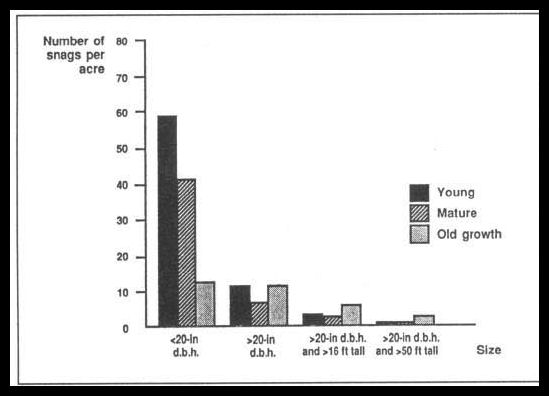
Figure 1.9-Number of snags per acre by size class in young, mature, and old-growth Douglas-fir stands in western Oregon and Washington; adapted from Spies and others (in press).
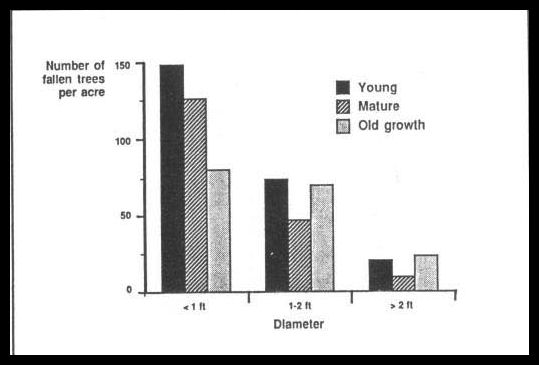
Figure 1.10-Numbers of fallen tree stems per acre by size class in young (Y), mature (M), and old-growth (0) Douglas-fir stands in western Oregon and Washington; adapted from Spies and others (in press).
Numbers of fallen trees in stands are generally similar to those of snags. Young stands often have the greatest numbers of fallen trees of all sizes, although old-growth stands have the highest numbers of large fallen trees (>24 inches) (fig. 1.10). Many young stands, probably established after fires in young- rather than old-growth forests, do not have large fallen trees and snags carried over from previous stands. Therefore, some young stands in the Coast Range do not fit this pattern; they have fewer fallen trees than old-growth stands have (Spies and others, in press).
Page 12
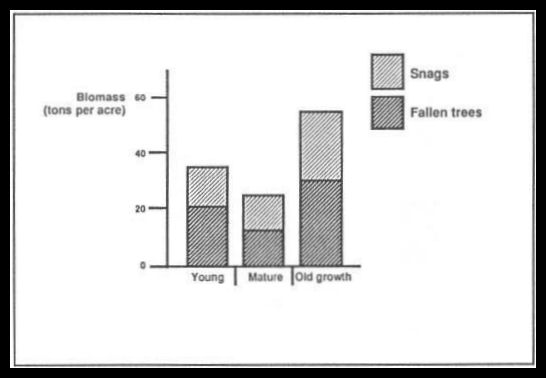
Figure 1.11-Mean biomass of total coarse woody debris in young, mature, and old-growth Douglas-fir stands in western Oregon and Washington; Spies and others (in press).
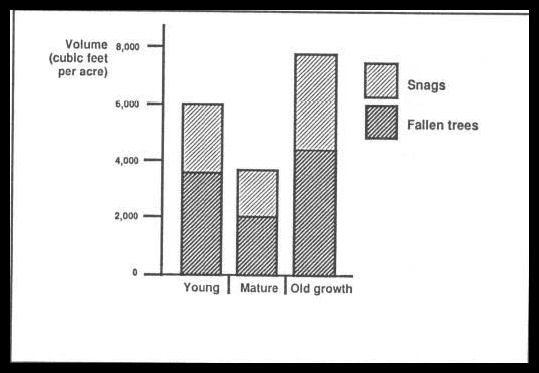
Figure 1.12-Mean volume of total coarse woody debris in young, mature, and old-growth Douglas-fir stands in western Oregon and Washington; adapted from Spies and others (in press).
In Douglas-fir forests of western Oregon and western Washington, the volume and biomass of woody debris in old-growth stands average about 7,175 cubic feet and 55 tons per acre, more than twice that of mature stands (figs. 1.11 and 1.12) (Spies and others, in press). The volume and biomass in many old-growth stands exceed 10,000 cubic feet and 76 tons per acre, and maximum values approach 24,300 cubic feet and 178 tons per acre. Young stands have intermediate levels of woody debris (figs. 1.11 and 1.12), whereas mature stands have the lowest volumes and biomasses.
Page 13
Spatial distribution.-- Coarse woody debris is unevenly distributed on the forest. The amount may vary tenfold between closely adjacent areas, and more than half the coarse woody debris may fall on less than one-fifth of the total area (Spies, unpublished data). Several factors contribute to such patchy distribution. The large successional overstory trees that contribute heavily to the dead wood supply are irregularly distributed. Mortality from natural causes is often patchy. Dead wood may be moved downslope to accumulate at a resting place on concave topography. In many oldgrowth stands, highly decayed wood is more evenly distributed than material of an intermediate decay level, although the opposite may be true in some young-growth stands because fires burn unevenly.
Stands on dry sites have less coarse woody debris than those of the same age on moist sites. In the east-central Coast Range, the amount of coarse woody debris in stands less than 150 years old is correlated with slope, aspect, and topographic position (Spies and others, in press). These relations may reflect differences in productivity between sites and in the frequency and severity of wildfire as it is affected by topography and dampness of sites.
Many mature stands on the west slope of the Coast Range have much more coarse woody debris than do mature stands on the east slope. High amounts of coarse woody debris in young and mature stands may result from cool-burning wildfires that kill only portions of the original old-growth stands in scattered patches, leaving many large snags and surviving old-growth trees. Large accumulations of coarse woody debris in the subsequent stand result from mortality of remnant old-growth trees, some of which were weakened by the fire.
Distribution of Coarse Woody Debris by Decay Class
Physical changes in snags and fallen trees have been arranged into five decay classes, based on readily observed physical characteristics (Cline and others 1980, Fogel and others 1973) (table 1.1). The distribution of total coarse woody debris biomass in these five decay classes varies with stand age (fig. 1.13). In the average young stand in the region, the highest biomass occurs in decay class IV. In mature and old-growth stands, the greatest proportion of woody debris often occurs in decay class III. The proportion of total biomass in highly decayed material (decay classes IV and V) generally decreases with stand age. Material from decay classes IV and V accounts for 57 percent of the total biomass in young stands but only 26 percent of the total biomass in old-growth stands. Across all age classes, however, differences in the absolute amounts of highly decayed material are relatively small. The relative differences among the age classes typically are least for decay class V and greatest for decay class III; the higher decay classes are a relatively more stable, slowly changing component of the dead wood in the system.
Page 14
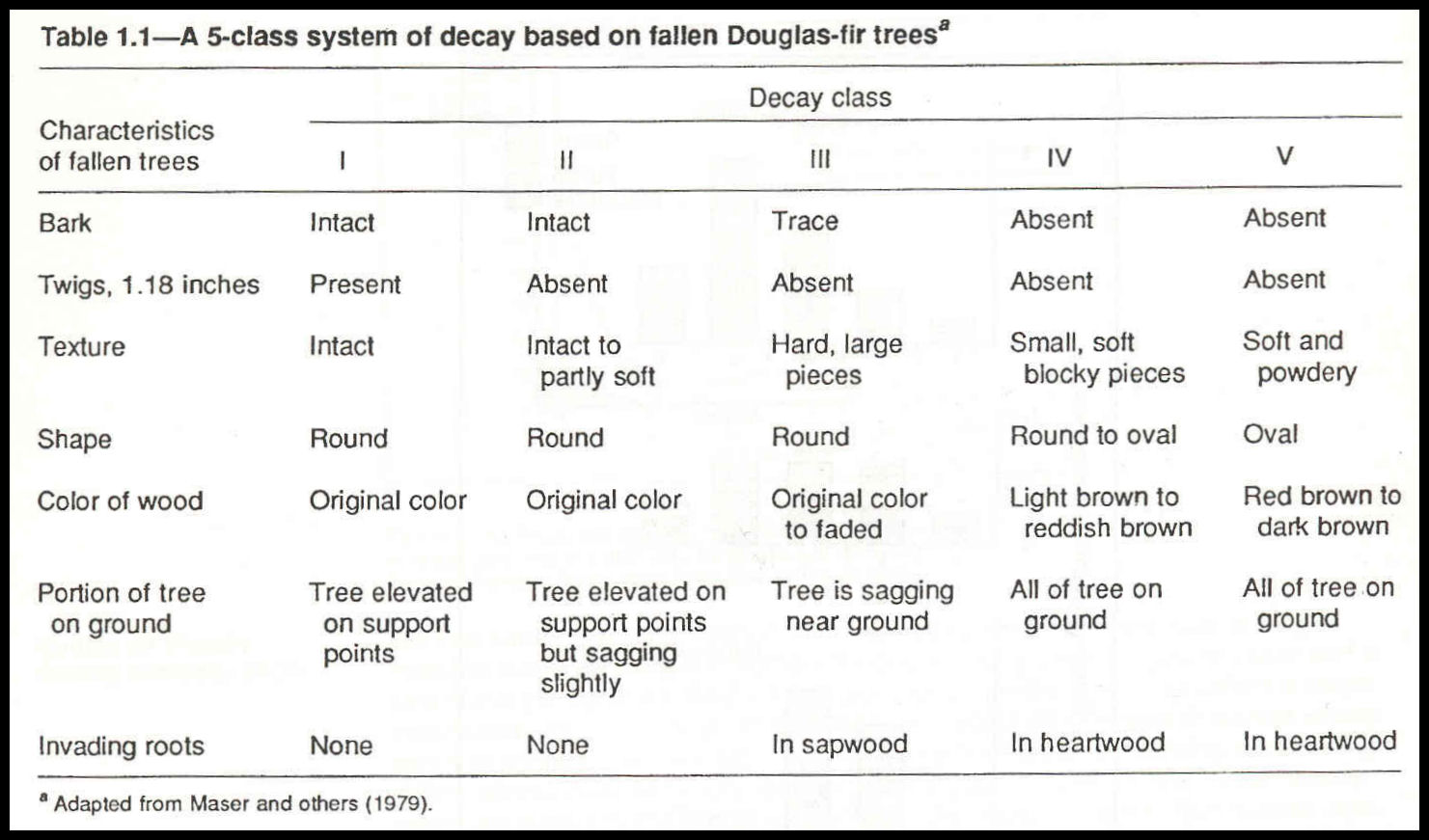
The ratio of woody debris in fallen trees to woody debris in snags increases as decay increases. Fallen trees constitute 32 percent of the woody debris in decay classes I and II and 71 percent in decay classes IV and V; most dead standing trees decay partially before falling. In the Coast Range, fallen trees constitute 42 percent of the material in decay classes I and II, a higher value than the regional estimate, perhaps because of the greater incidence of wind-related mortality in the Coast Range.
Page 15
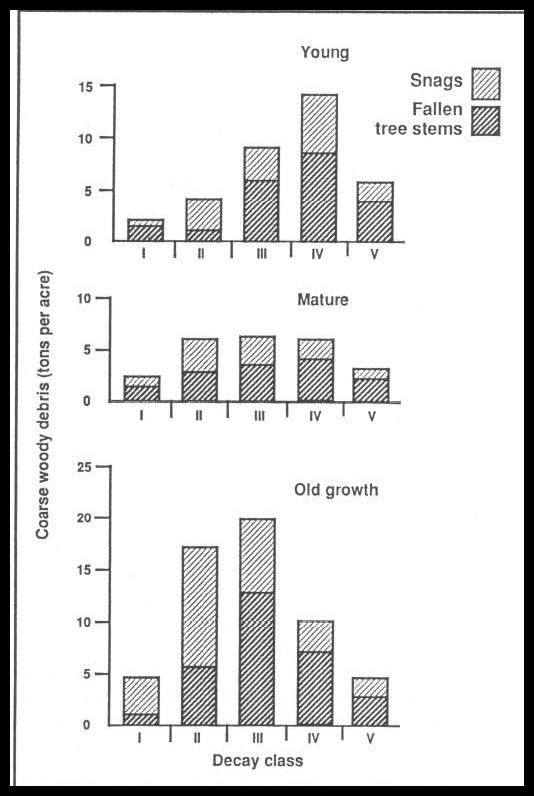
Figure 1.13-Distribution of mean total coarse woody debris by decay class in young, mature, and old-growth Douglas-fir stands in western Oregon and Washington; adapted from Spies and others (in press).
Carryover Woody Debris
Carryover woody debris is the coarse woody debris in a current stand that was laid down in the previous stand, often old-growth. Young stands with large amounts of coarse woody debris inherited it from the previous stand. Those that have small amounts are mostly in the south and east Coast Range where multiple wildfires in the past 150 years consumed much of the coarse woody debris.
Page 16
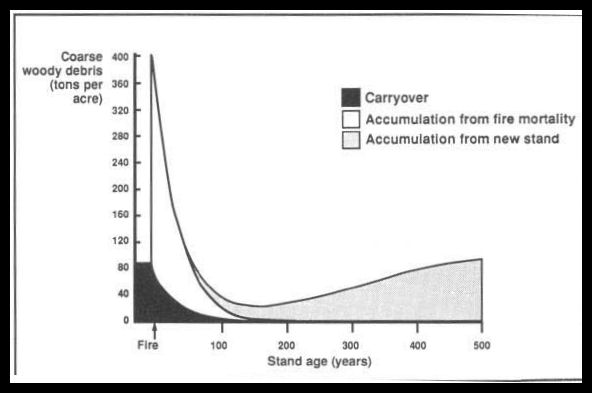
Figure 1.14-Predicted changes in coarse woody debris after a catastrophic fire in a 450-year-old Douglas-fir-western hemlock forest; adapted from Spies and others (in press).
Cycles of Woody Debris Accumulation
Several patterns of accumulation of woody debris occurred in the past. A simple scenario would be a major disturbance killing an old-growth Douglas-fir stand and a new stand becoming established and growing for hundreds of years before a major disturbance (fig. 1.14). At stand age 500 years, about 80 tons/acre of coarse woody debris is present. Then a major stand-replacing fire occurs, consuming some woody debris, although about 67 tons/acre remains. Large amounts of new coarse woody debris are added by the fire, which destroys few large live stems. This sudden injection of dead wood adds 180 to 450 tons/acre. A new Douglas-fir stand is established soon after the fire. A period of 30 to 40 years passes before the canopy closes and mortality adds more coarse woody debris to the site. Decay reduces coarse woody debris by more than 50 percent during this time, but amounts are still high because of large input after the fire. By age 100, the accumulation of coarse woody debris is at a low point because almost all the coarse woody debris present immediately after the disturbance is now gone, and additions of new dead wood from the developing stand are less than losses from decomposition. At this point, more than 50 percent of the coarse woody debris is inherited from the previous stand.
After age 100, coarse woody debris increases gradually as a result of mortality of the canopy trees. As canopy tree size increases, coarse woody debris also increases and probably peaks somewhere between 400 and 600 years. New woody debris comes increasingly from the death of western hemlocks at about age 500. The standing crop of woody debris decreases gradually toward a lower equilibrium, after 1,000 years, when Douglas-fir passes from the stand. The last Douglas-fir dies at age 1,200 years, and evidence of it can still be found 300 or more years later.
Page 17
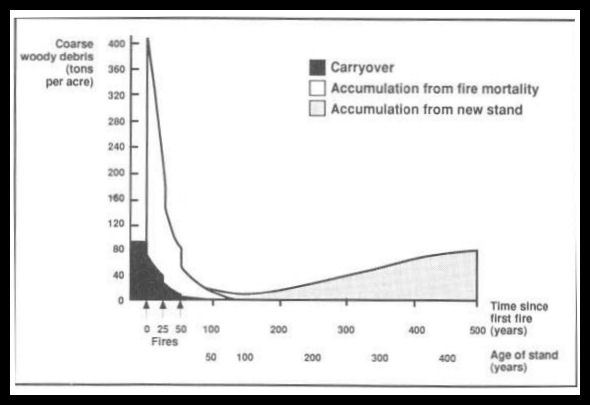
Figure 1.15-Predicted changes in coarse woody debris after a catastrophic fire in a 450-year-old Douglas-fir-western hemlock forest and two fires 25 and 50 years later; adapted from Spies and others (in press).
The scenario above is probably not the most common because disturbances, such as fire, may recur several times, especially in the first 30 to 50 years of a new stand when fine fuel levels are high. Multiple fires would consume more woody debris and live biomass over time than a single fire and would reduce the amount of carryover in the young stands, so that the site would have relatively low amounts of woody debris for 200 to 300 years (fig. 1.15). Multiple fires would delay the addition of new material and prolong the period of low accumulation, which would reduce the minimum accumulation.
The Intensively Managed Plantation
Effect of Plantation Management on Coarse Woody Debris
Thus far, we have discussed the unmanaged forest, which is rapidly being replaced by plantations in which various phases of biological development are controlled to produce maximum wood fiber in the shortest time. Plantation establishment decides species distribution and initial tree density. Periodic mechanical thinning and removal of logs replaces the self-thinning of unmanaged stands that provided coarse woody debris from dead stems. In the plantation, production of coarse woody debris is minimized, and uniformity-rather than diversity-is fostered.
Most plantations in the Douglas-fir region are established after an old forest has been clearcut. The first step in plantation establishment is to reduce the coarse woody debris accumulated before and during logging. Coarse woody debris is reduced most often for three reasons: to increase use of woody debris, to clear sites for tree planting, and to reduce fire risk.
Page 18
Wood utilization standards assume that any piece of dead wood that has sufficient strength to withstand yarding is usable (Howard 1981). At least 14 variables may influence the amount of coarse woody debris that remains after logging (Howard1978):
1. Stand age
2. Gross cruise volume per acre
3. Percentage of stand defect
4. Average slope percent
5. Size of clearcut
6. Average stand diameter
7. Percentage of exportable volume
8. Estimated distance to nearest processing center
9. Estimated hauling distance on secondary roads
10. Percentage of whitewoods in stand
11. Percentage of western redcedar
12. Appraised stumpage value
13. Current utility lumber price index
14. Current general lumber price index
Unusable material is often yarded into piles close to roads. Much of the heavily decayed material is broken into fine organic matter. Most logged areas then are broadcast burned to remove remaining coarse woody debris and finer woody material for easier tree planting. Such fire consumes fine fuels-limbs, branches, and litter.
To help us understand the effects of intensive removal of coarse woody debris, we used a model to simulate the dynamics of coarse woody debris in Douglas-fir plantations (fig. 1.16). The model represents a Douglas-fir stand established naturally on site II land. The stand was precommercially thinned to 300 trees/acre at age 11 years; commercially thinned at ages 31, 40, 53, 68, and 83; and harvested at age 100 (table 10C in Curtis and others 1982). We assumed that this stand became naturally established after an old-growth Douglas-fir stand was clearcut. The stand had a harvest volume of about 100,000 board feet per acre and a coarse woody debris volume of 10,000-11,400 cubic feet/acre (80-89 tons/acre) (Spies and others, in press). In this example, the minimum diameter of woody debris is 3 to 4 inches, depending on data source. The rate of disappearance of coarse wood was assumed to be 3 percent per year (Graham 1982; Sollins 1982; Sollins and Cline 1987;Spies and others, in press).
The model assumes that 80 tons/acre of coarse woody debris are on the site before logging. By the end of the first 100 years of the plantation, only 20 tons/acre remain and only 4 of the original 80 tons are still on the site. New coarse woody debris would be added as logging slash (62 percent) and dead trees (38 percent) at a rate of about 0.4 ton/acre between age 30 and final harvest (fig. 1.16).
During a second 100-year rotation of the simulated, manipulated forest, total coarse woody debris decreased from 24 tons/acre at the beginning of the rotation to only 5 tons at the end of 100 years, before harvest.
Page 19
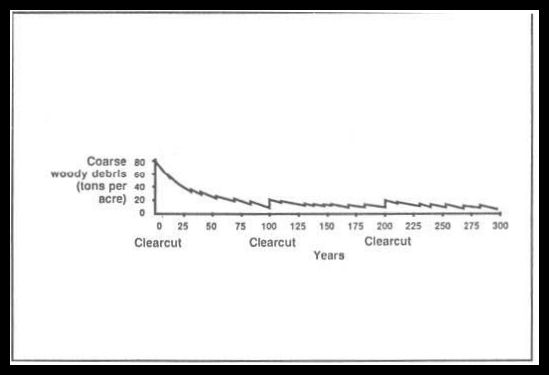
Figure 1.16-Predicted changes in coarse woody debris in three rotations of an intensively managed forest after clearcutting of a 450-year-old Douglas-fir-western hemlock stand. The small peaks represent accumulations of coarse woody debris after thinnings. The peaks also include natural mortality that occurred between thinnings.
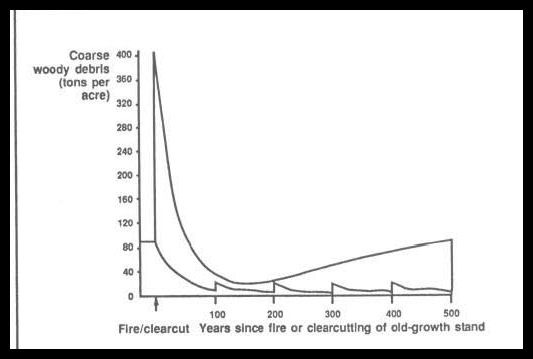
Figure 1.17-Comparison of predicted changes in coarse woody debris during 500 years of natural Douglas-fir forest development and five rotations of an intensively managed Douglas-fir forest.
We have compared coarse wood loadings during the life of a 500-year-old forest with five l00-year plantation rotations (fig. 1 .17). Several major differences between coarse woody debris in a forest and in plantations occur over the five centuries. At least six times more wood carries over after wildfire in old growth than would have carried over after logging in an old-growth stand. The carryover coarse woody debris after wildfire is abundant the next 90 to 100 years. On the plantation, more than 8,500 cubic feet/acre of the large wood that would have carried over is removed as
Page 20
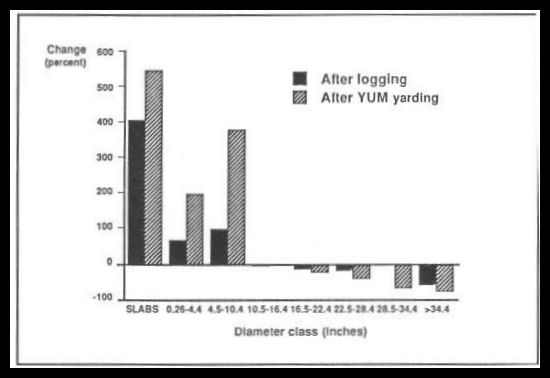
Figure 1.18--Relative change in percentage of volume of woody residue by size class after logging and yarding unmerchantable material (YUM) in two Douglas-fir stands in western Oregon (after Pong and Henley 1978).
a product. Coarse woody debris cannot accumulate to levels reached by the 500-year-old forest if l00-year rotations are the maximum prescribed. Coarse woody debris follows a variable pattern during formation of the 500-year-old forest. After decreasing from a maximum after wildfire to a minimum at l00-150 years, coarse woody debris accumulations begin to increase as large trees die.
A second difference between the forest and plantations lies in the size of the trees and their wood quality. The short-rotation plantation produces smaller diameter trees that disappear more rapidly than large trees because they decay faster.
The size of wood left after disturbances differs greatly between forests and plantations. In the forest, disturbances leave large pieces of coarse woody debris. In the plantation, clearcutting leaves relatively small material-branches and small-diameter tops (figs. 1.18 and 1.19). Inherited coarse woody debris, especially class IV and V material, is broken up during harvest.
Page 21
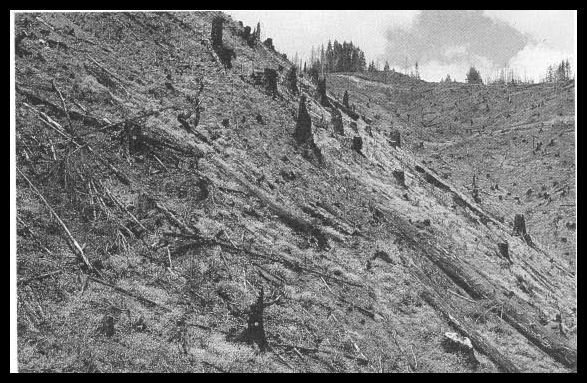
Figure 1.19-Clearcut 2 years after harvest showing low carryover of coarse woody debris.
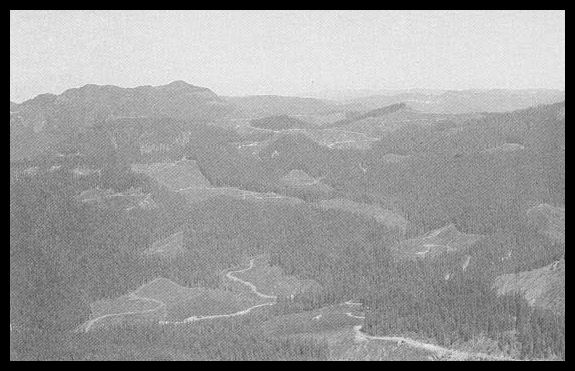
Figure 1.20-Size and pattern of forest "disturbances" in a managed landscape. A final difference in coarse wood dynamics between forests and plantations is in the input rate during stand development. In the forest, self thinning and other mortality proceeds uninhibited and woody debris accumulates. In a plantation, loss of trees is substantially slower, and the trees that do die are harvested.
Short-rotation plantations greatly reduce coarse woody debris, which changes the functional characteristics of the ecosystem. Drastically reduced accumulations of coarse woody debris could seriously impair the function of plantations as vertebrate habitat and might reduce productivity (Bartels and others 1985, Maser and Trappe 1984b, Neitro and others 1985). In the intensively managed landscape, no more periodic large inputs of coarse woody debris is expected; and the size, severity, and pattern of the disturbances will vary less (fig. 1.20). Ecological diversity will be greatly reduced.
Page 22
The intensively managed landscape differs from the unmanaged landscape in how it changes with time. The levels of coarse woody debris in the managed landscape will change little. In the unmanaged landscape, irregularity in the frequency of past disturbances ensures that, during a several-hundred-year period, a given site will experience periods of both very high and relatively low accumulations of woody debris. These periodic large inputs, which help maintain soil organic matter and site productivity, are not planned for plantations in which many rotations may pass without large inputs of woody debris.
Page 23
Page 24 had figures not placed where the belonged in the doc. I added them to the right location so this page is blank.
Page 24